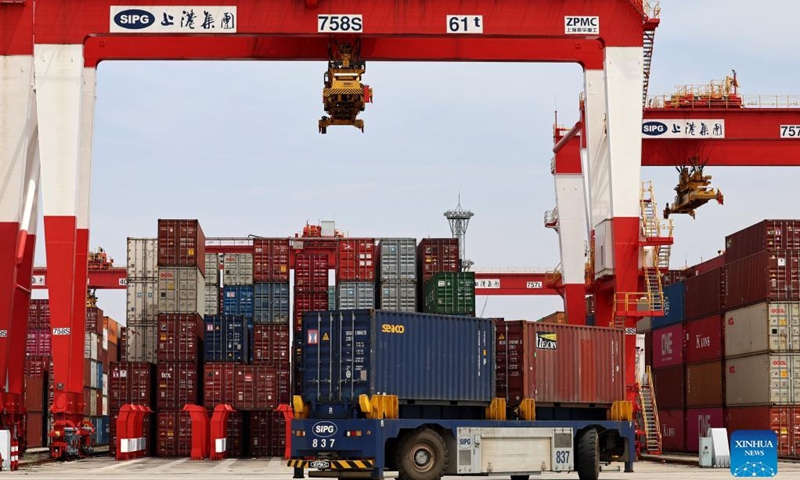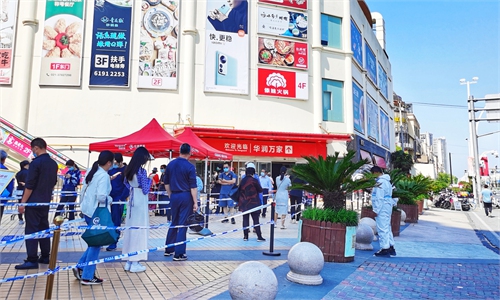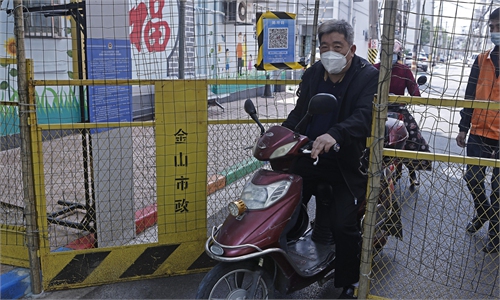China April economic data down on Omicron impact; more pro-growth measures in pipeline

A truck carrying containers is seen at the container dock of Shanghai's Yangshan Port in east China, April 27, 2022. About 25,000 staff members stick to their posts in Shanghai port to guarantee water transportation and improve logistics efficiency amid challenges caused by the recent resurgence of COVID-19 in Shanghai.(Photo: Xinhua)
As the effects of Omicron onslaught on the economy further intensified, weighing down on April industrial production, retail sales and investment, an official with the National Bureau of Statistics (NBS) said there are signs of improvement in May and growth in the second quarter is expected to remain stable.
Analysts have claimed that the second quarter may see the economy hit rock bottom with growth expected to be around 4 percent, but as recovery is expected to further gain pace in June and the third quarter, the economy still has the chance of achieving an annual growth target of around 5.5 percent.
Industrial production contracted by 2.9 percent year-on-year in April, down from a growth of 5 percent in March and retail sales shrank by more than 11 percent, according to the NBS on Monday. Both figures were lower than market expectations, reflecting the epidemic's weight on the economy.
Fixed-asset investment saw a year-on-year increase of 6.8 percent in the first four months, down 2.5 percentage points compared with the first quarter.
However, despite the epidemic dealt a blow to the economy in April, the effects are "short-term and external," and the Chinese economy's fundamentals remain positive and the trend of high-quality development remains unchanged, according to Fu Linghui, spokesperson for the NBS.
Fu said as the domestic COVID situation has eased since mid-April, the economy is expected to see improved performance, noting that Shanghai and Northeast China's Jilin Province were already in the process of resuming work and production and putting economic activity back on track.
Cao Heping, an economist from Peking University, told the Global Times on Monday that the epidemic's direct impact on financial hub Shanghai as well as indirect impact on the Pearl River Delta and the Yangtze River Delta - the two most dynamic economic regions in China since March - were reflected in the poor data in April and the downward pressure China faced in April is the most serious challenge since the first quarter of 2020, when the COVID-19 outbreak first hit Wuhan, Central China's Hubei Province.
Road to recovery
Analysts said the epidemic in Shanghai could have taken away half of the city's GDP in April, and factoring in the ripple effects across the surrounding Yangtze River Delta, the drag on the national economy could reach 0.2 percentage points in April.
With static management lasting through April, the current round of the epidemic could have undercut the country's annual GDP growth by 0.4 percentage points, Cao said.
As Shanghai is resuming work and production, up to 60 percent of the negative impact could be reversed if things go well, reducing the drag on the national GDP to around 0.2 percentage points, Cao said.

Industrial production in the Yangtze River Delta was down 14.1 percent in April due to the Omicron surge in Shanghai, home to the country's largest automaker SAIC Motor and the figure for the Northeastern part of the country dropped by 16.9 percent because of the outbreak in Jilin Province, a car manufacturing hub.
Tian Yun, former vice director of the Beijing Economic Operation Association, told the Global Times on Monday that the April data also showed that for manufacturing, Chinese workers were willing to work overtime to make up for the loss, revealing a possibility unique to China.
On the bright side, analysts pointed out the added industrial value of high-tech manufacturing maintained its growth momentum in April, bucking the trend by posting a growth of 4 percent while investment in the high-tech sector grew by 22 percent in the first four months, showing the resilience of a vital sector important to China's economic future.
Zhou Maohua, a macroeconomic analyst at Everbright Bank, told the Global Times on Monday that the strong output and investment in the upstream industrial sector, stable supply and prices of food, energy and raw materials should provide solid support for the domestic economic recovery, even as global commodity prices soared.
It is expected that consumption will warm up in May as domestic COVID-19 outbreaks are gradually put under control and the pent-up demand for goods and services picks up, Zhou said.
Economy to continue growth in Q2
When asked about the risk of the economy plunging into negative territory, Fu said China's economy is still expected to achieve "relatively sound" growth in the second quarter, as measures have been taken to support investment and the manufacturing sector, while consumption will gradually recover during the quarter to drive stable economic growth.
China has rolled out a series of pro-growth measures, including the latest measures from financial authorities to further cut the mortgage loan interest on Sunday to shore up the real estate sector.
Fu said investment, consumption and exports, three drivers of the economy, will all record growth in the next phase.
Liao Qun, chief economist of the Chongyang Institute for Financial Studies at Renmin University of China, said as Shanghai and a number of other cities gradually walk out of static management against the epidemic, the national economy will regain some lost ground.
"It seems that May data will definitely be better than April's, so the question to ask is whether May data will be better than March's," Liao said.
Xing Zhaopeng, senior China strategist at Australia and New Zealand Banking Group, told the Global Times that the priority is to restore business sentiment by a strong stimulus and to tweak the anti-COVID measures. "The baseline scenario is that the Chinese economy will gradually bottom out in May and June," Xing said.
The Chinese economy seemed to have hit its lowest point in April, Lian Ping, head of Zhixin Investment Research Institute, told the Global Times on Monday.
Lian noted that a relatively fast pace of special bond issuance in the first quarter and the rollout of infrastructure projects underpinned that infrastructure investment retained moderate growth while manufacturing investment maintained double digits growth in the first four months, showing the government's support for private firms is having an effect despite the virus.
As work resumption is progressing in an orderly manner and the COVID-19 restrictions are being lifted, Lian expects to see more improvement on both sides in supply and demand in the coming month.
However, analysts noted the need to scale up supportive measures with "unprecedented downward headwinds since the first quarter of 2020" due to COVID-19 flare-ups, supply chain snags and external uncertainties arising from the Russia-Ukraine conflict. They also noted that it is important that these measures take effect in conjunction with the release of pent-up demand due to COVID curbs.
Tian noted that the central government may step up its support to issue more consumption vouchers to drive up consumption, with increased value and extended coverage to include more unconventional items including education expenditure, medical treatment and tourism.
"It is vital to step up policy efforts in the second quarter and beyond with incremental policy tools and make sure they are implemented with strength and early deployment," Lian said.
Cao said if the economy could gradually stage a rebound in June, the GDP could still reach above 4 percent in the second quarter, which means reaching the annual growth goal is still plausible on the back of serious efforts in the second half.
To that end, China will need more pro-growth monetary policies to produce synergy in an already working fiscal policy, Cao said.
Liao suggested to give more power to fiscal support policies, the deficit ratio could be raised to over 3 percent, as the economic situation has markedly worsened since the drawing of the Government Work Report, which set the rate at around 2.8 percent.
Analysts have claimed that the second quarter may see the economy hit rock bottom with growth expected to be around 4 percent, but as recovery is expected to further gain pace in June and the third quarter, the economy still has the chance of achieving an annual growth target of around 5.5 percent.
Industrial production contracted by 2.9 percent year-on-year in April, down from a growth of 5 percent in March and retail sales shrank by more than 11 percent, according to the NBS on Monday. Both figures were lower than market expectations, reflecting the epidemic's weight on the economy.
Fixed-asset investment saw a year-on-year increase of 6.8 percent in the first four months, down 2.5 percentage points compared with the first quarter.
However, despite the epidemic dealt a blow to the economy in April, the effects are "short-term and external," and the Chinese economy's fundamentals remain positive and the trend of high-quality development remains unchanged, according to Fu Linghui, spokesperson for the NBS.
Fu said as the domestic COVID situation has eased since mid-April, the economy is expected to see improved performance, noting that Shanghai and Northeast China's Jilin Province were already in the process of resuming work and production and putting economic activity back on track.
Cao Heping, an economist from Peking University, told the Global Times on Monday that the epidemic's direct impact on financial hub Shanghai as well as indirect impact on the Pearl River Delta and the Yangtze River Delta - the two most dynamic economic regions in China since March - were reflected in the poor data in April and the downward pressure China faced in April is the most serious challenge since the first quarter of 2020, when the COVID-19 outbreak first hit Wuhan, Central China's Hubei Province.
Road to recovery
Analysts said the epidemic in Shanghai could have taken away half of the city's GDP in April, and factoring in the ripple effects across the surrounding Yangtze River Delta, the drag on the national economy could reach 0.2 percentage points in April.
With static management lasting through April, the current round of the epidemic could have undercut the country's annual GDP growth by 0.4 percentage points, Cao said.
As Shanghai is resuming work and production, up to 60 percent of the negative impact could be reversed if things go well, reducing the drag on the national GDP to around 0.2 percentage points, Cao said.

A Shanghai resident walks his golden retriever on May 16, 2022 when the city gradually resumes small businesses. Photo: Wu Chuanhua/Global Times
Growth in the energy and basic industries was unable to offset a marked slowdown in manufacturing, which was hit hard in April featuring a sharp decrease in the auto sector, among others, according to NBS.Industrial production in the Yangtze River Delta was down 14.1 percent in April due to the Omicron surge in Shanghai, home to the country's largest automaker SAIC Motor and the figure for the Northeastern part of the country dropped by 16.9 percent because of the outbreak in Jilin Province, a car manufacturing hub.
Tian Yun, former vice director of the Beijing Economic Operation Association, told the Global Times on Monday that the April data also showed that for manufacturing, Chinese workers were willing to work overtime to make up for the loss, revealing a possibility unique to China.
On the bright side, analysts pointed out the added industrial value of high-tech manufacturing maintained its growth momentum in April, bucking the trend by posting a growth of 4 percent while investment in the high-tech sector grew by 22 percent in the first four months, showing the resilience of a vital sector important to China's economic future.
Zhou Maohua, a macroeconomic analyst at Everbright Bank, told the Global Times on Monday that the strong output and investment in the upstream industrial sector, stable supply and prices of food, energy and raw materials should provide solid support for the domestic economic recovery, even as global commodity prices soared.
It is expected that consumption will warm up in May as domestic COVID-19 outbreaks are gradually put under control and the pent-up demand for goods and services picks up, Zhou said.
Economy to continue growth in Q2
When asked about the risk of the economy plunging into negative territory, Fu said China's economy is still expected to achieve "relatively sound" growth in the second quarter, as measures have been taken to support investment and the manufacturing sector, while consumption will gradually recover during the quarter to drive stable economic growth.
China has rolled out a series of pro-growth measures, including the latest measures from financial authorities to further cut the mortgage loan interest on Sunday to shore up the real estate sector.
Fu said investment, consumption and exports, three drivers of the economy, will all record growth in the next phase.
Liao Qun, chief economist of the Chongyang Institute for Financial Studies at Renmin University of China, said as Shanghai and a number of other cities gradually walk out of static management against the epidemic, the national economy will regain some lost ground.
"It seems that May data will definitely be better than April's, so the question to ask is whether May data will be better than March's," Liao said.
Xing Zhaopeng, senior China strategist at Australia and New Zealand Banking Group, told the Global Times that the priority is to restore business sentiment by a strong stimulus and to tweak the anti-COVID measures. "The baseline scenario is that the Chinese economy will gradually bottom out in May and June," Xing said.
The Chinese economy seemed to have hit its lowest point in April, Lian Ping, head of Zhixin Investment Research Institute, told the Global Times on Monday.
Lian noted that a relatively fast pace of special bond issuance in the first quarter and the rollout of infrastructure projects underpinned that infrastructure investment retained moderate growth while manufacturing investment maintained double digits growth in the first four months, showing the government's support for private firms is having an effect despite the virus.
As work resumption is progressing in an orderly manner and the COVID-19 restrictions are being lifted, Lian expects to see more improvement on both sides in supply and demand in the coming month.
However, analysts noted the need to scale up supportive measures with "unprecedented downward headwinds since the first quarter of 2020" due to COVID-19 flare-ups, supply chain snags and external uncertainties arising from the Russia-Ukraine conflict. They also noted that it is important that these measures take effect in conjunction with the release of pent-up demand due to COVID curbs.
Tian noted that the central government may step up its support to issue more consumption vouchers to drive up consumption, with increased value and extended coverage to include more unconventional items including education expenditure, medical treatment and tourism.
"It is vital to step up policy efforts in the second quarter and beyond with incremental policy tools and make sure they are implemented with strength and early deployment," Lian said.
Cao said if the economy could gradually stage a rebound in June, the GDP could still reach above 4 percent in the second quarter, which means reaching the annual growth goal is still plausible on the back of serious efforts in the second half.
To that end, China will need more pro-growth monetary policies to produce synergy in an already working fiscal policy, Cao said.
Liao suggested to give more power to fiscal support policies, the deficit ratio could be raised to over 3 percent, as the economic situation has markedly worsened since the drawing of the Government Work Report, which set the rate at around 2.8 percent.



